Food, Conversations and More | Spanish: Elementary A2 Level - Class 6 PDF Download
Spanish Food
In this Teaching Wiki, we'll explore all kinds of Spanish food, as well as its origins and popularity. Includes links to KS2 teaching resources.
What is Spanish food?
'Spanish food' covers the cooking practices and traditions which are common in Spain and Spanish-speaking countries.

Reading about Spain and its delicious food is one way to support your teaching of food vocabulary and grammar in your primary Spanish lessons.
As well as fun facts about Spanish food, this Teaching Wiki also provides handy links to some of our resources for teaching food in Spanish.
Try not to drool too much. Let’s tuck in!
How do you say ‘food’ in Spanish?
The Spanish word for food is ‘comida’. This noun can refer to a meal, lunch, dinner, or an evening meal. Here are some common Spanish phrases that use the word ‘comida’:
- comida a domicillo = meals on wheels
- comida basura = junk food
- comida casera = home cooking
- comida infantil = baby food
- comida para gatos = cat food
- comida para perros = dog food
- comida precocinda = ready meals
- comida rápida = fast food
- comida reconfortante = comfort food
In Latin America, which is said to include South and Central America and certain Caribbean islands, the word ‘alimento’ is also used to mean food in Spanish.
Its direct translation is actually ‘that which nourishes’ or sustenance. It’s a masculine noun and generally more formal than ‘comida’. For example:
La leche maternizada provee alimento abundante a los bebés.
The formula provides ample nourishment for infants.
The History Of Spanish Food
As with most cultures, Spain is a melting pot of lots of different ingredients and recipes. Spanish food can be traced back to many cultures and time periods.
It has derived lots of ingredients from the rest of Europe, including olive oil from Greece, grapes from Italy, beer from Germany. And it has also taken on influences from Africa cuisine withmany spices, rice, and exotic fruits and vegetables introduced.
Thanks to a combination of European and African ingredients, Spanish food has become one of the world’s most loved cuisines.
The Geography Of Spain And Its Food
Spain is mostly surrounded by water, so seafood is a big part of the Spanish diet.
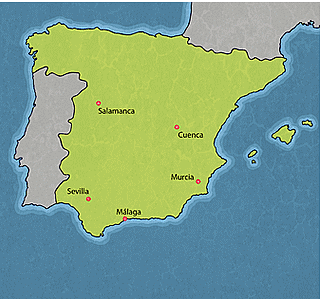
The rest of Spain is made up of mountain ranges, fertile farmlands, huge pastures and lots more, which help Spain to produce plenty of fresh and delicious produce.
Spain, is known for its healthy Mediterranean diet because, thanks to its unique location, it has easy access to fresh fruits and vegetables, fresh seafood, grains and olive oil.
What kinds of food are popular in Spain?
Spanish food is fresh, flavoursome and generally considered to be healthy - must be all those fresh fish, olive oil and fresh fruits and vegetables. Thanks to all these ingredients, the Spaniards have some truly lip-smacking dishes.
Tortilla
This is the humble Spanish omelette. This can be cooked with lots of delicious ingredients including peppers, chorizo and cheese. But the traditional Spanish tortilla should only be made with eggs, onion, and potatoes.
Chorizo
This is a staple of Spanish cuisine and is famous around the world. This is a spicy, dry cured sausage which can be eaten on its own or used in other dishes such as stews, paella, salads or soups. Chorizo is spiced with plenty of paprika, so gives dishes a deep and rich flavour.
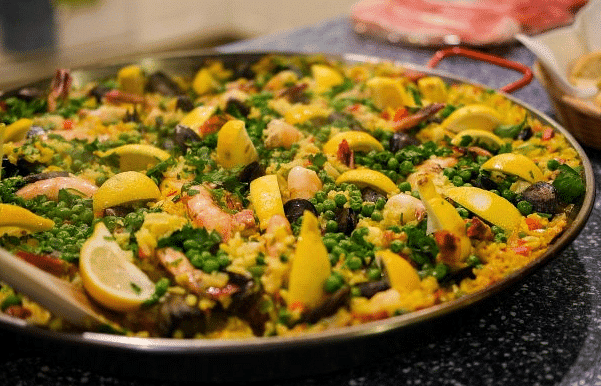
Paella
Paella is one of Spain’s most famous dishes. It is a rice dish that is commonly cooked on a giant pan and uses all sorts of ingredients.
There are many ways you can cook paella, but the traditional Spanish paella is made using rice, vegetables, stock, chicken thighs, prawns, mussels and squid*.
Saffron is a famous Spanish spice which is used in paellas to give it that bright orange colour. Paella dates back hundreds of years and was eaten by farmers for lunch in the fields and was made using rice and other ingredients they could get their hands on such as tomatoes, snails, rabbit and beans.
*You should NEVER put chorizo in your paella!
Fideuà
This is the cousin to the paella. It's a seafood dish cooked with similar ingredients to the paella but includes thin noodles, instead of rice, and is cooked using a fish stock. This dish includes more fish as a paella and traditionally uses monkfish. It originates from the coast in Valencia.
Patatas bravas
Most cultures have their own take on a fried potato recipe, and the Spanish aren’t any different.
'Patatas bravas' translates as ‘spicy potatoes’ and is a dish made from fried, cubed potatoes which is usually covered in a spicy tomato sauce. The sauce is usually made using tomatoes and pimento, which is a sweet paprika.
This dish was first created in Madrid and is popular with Spaniards as it is a cheap and relatively healthy dish. The 'patatas' can also be served with aioli, which is a garlic and olive oil sauce.
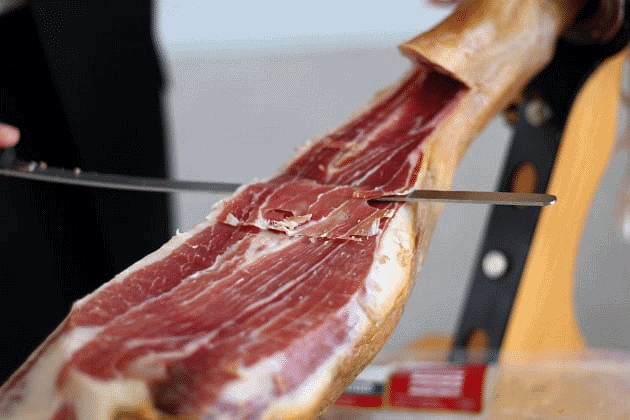
Jamón
Jamón is Spanish ham which is salted and left to cure for around 12 months, or sometimes even longer! There are lots of different hams, but basically they can be condensed down to two varieties; jamón serrano and jamónIberico.
Jamon iberica is considered to be one of the finest and most expensive hams in the world, as it is made from Black Iberian pigs which are fed on a diet of mostly acorns, which are found in abundance in the area.
Croquetas
These are Spanish croquettes which are filled with a creamy béchamel sauce and fried. These are often served as a snack, and as a popular bar snack, and can also come filled with other ingredients such as mushrooms, ham, chicken or salt cod.
Gambas al ajillo
As we know, Spain loves its seafood, and the most popular dish is prawns. The dish consists of prawns cooked with olive oil, garlic and a pinch of chilli for an extra kick.
It is often served with bread to mop up that delicious garlic sauce. This is a dish that can be eaten on its own or as part of tapas. Speaking of tapas...
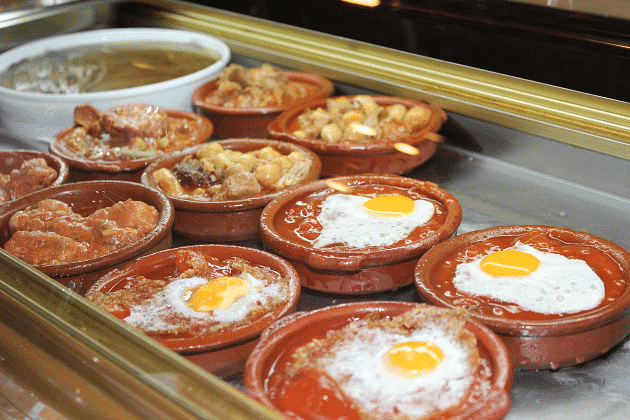
Tapas
And finally we end on the classic: Tapas. Tapas is lots of small dishes which are shared around a table, usually as a snack before lunch and dinner.Although, most people outside of Spain have tapas as a full meal.
The small dishes include all sorts of Spanish food such as tortilla, prawns, patatas bravas, meatballs, fresh bread, cheese, ham, roasted vegetables, and lots more!
Desserts
Spain has a variety of desserts which mainly consist of eggs, cream and lots of cinnamon. There are also some soft and cheesy desserts too. But what are the most popular?
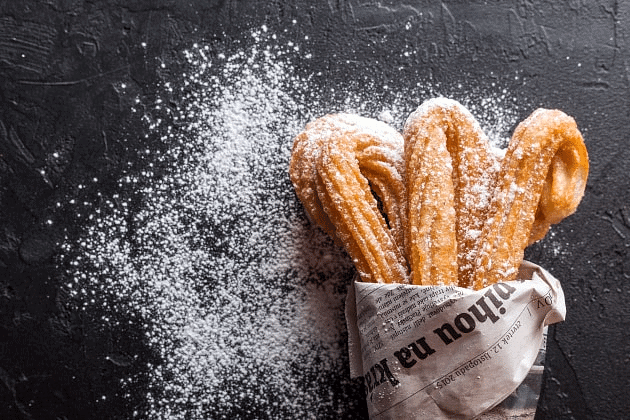

Churros are long strips of light batter that are fried, covered in sugar and cinnamon and dipped in a chocolate sauce.
It’s the most famous Spanish desert, known all over the world, but, here’s the thing... in Spain, churros aren’t eaten as a dessert!
Churros are actually eaten as a breakfast or a snack! So if you were looking for an actual traditional Spanish dessert, you are better off asking for...
Flan
The name doesn’t sound too appetizing, but the flan is one of the most popular desserts in Spain. The flan is made from eggs, cream and sugar and is like a wobbly jelly. It's usually covered in a rich caramel sauce or syrup.

Crema Catalana
This is the most famous dessert in Catalonia. This is a creamy custard made from egg yolks, milk, sugar, cinnamon and orange. The top is then covered with sugar and cooked, which you then crack with a spoon. Delicious.
Arroz con leche
This translates as ‘rice with milk’ and is Spain’s version of a rice pudding. This is often served cold and uses the same rice as paella, so gives the dessert a little crunch. The rice is cooked with milk, sugar, cinnamon (of course) and lemon peel.
Fun Facts About Spanish Food
Here are some fun facts about Spanish food which you can share with your children to get some tummies rumbling:
- Around 75% of the world’s saffron is made in Spain. Saffron is a spice which is used in lots of dishes including paella, soups, risottos and also in fragrances, dyes and medicines.
- Spain is the world’s top provider of Olive oil, even over Greece and Italy!
- Instead of a bowl of a nice warm bowl of soup, Spaniards often enjoy cold soups such as el ajo blanco and el gazpacho.
- Eggs are used for lunches and dinners NOT for breakfast!
- Tapas originates from the word ‘tapa’ which means, ‘cover’, so tapas the dish derives from when Spaniards used to cover their glasses with a slice of ham or cheese!
- The Spanish don’t usually have their dinner until around 9pm, or in the summer months even later.
We hope you enjoy these fun facts about Spanish food! After you have told these to your children, you might find the below resources useful in your Spanish lessons.
|
12 videos|17 docs|11 tests
|
FAQs on Food, Conversations and More - Spanish: Elementary A2 Level - Class 6
| 1. What is Spanish food? |  |
| 2. How do you say ‘food’ in Spanish? |  |
| 3. What is the history of Spanish food? |  |
| 4. What kinds of food are popular in Spain? |  |
| 5. What are some fun facts about Spanish food? |  |




















